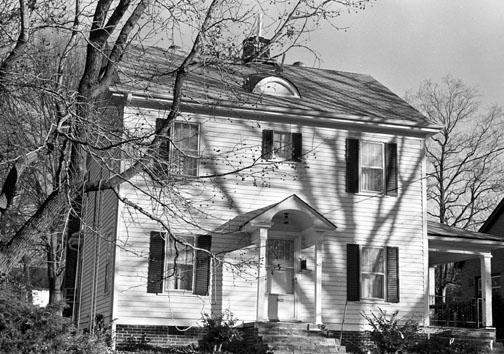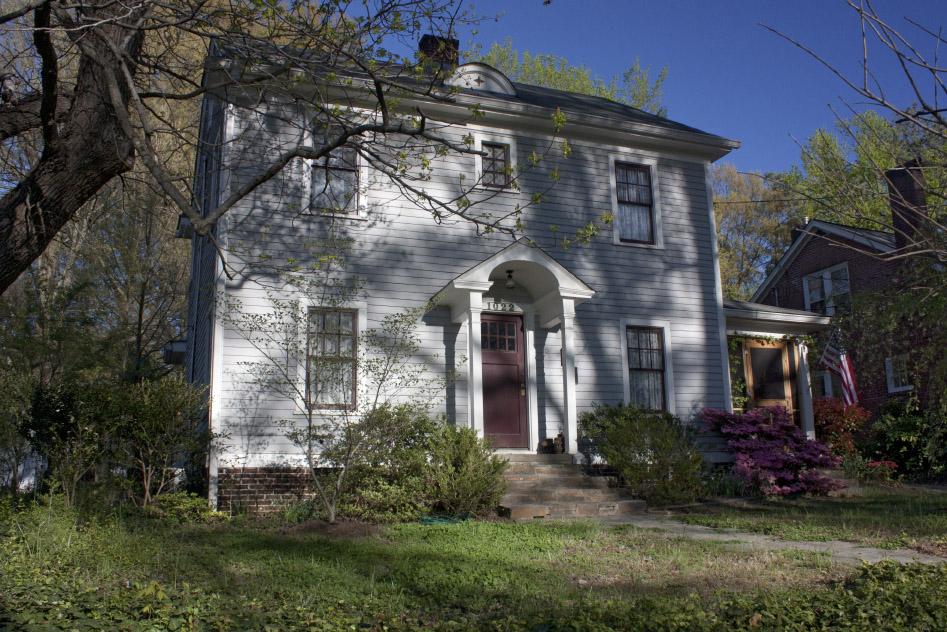(The information below in italics is from the Historic Preservation Society of Durham Plaque Application for the Mamie C. Norwood House)
In 1928, when Rosehill Avenue was still a dirt lane, Widow Mamie Norwood ordered her dream home from a Sears & Roebuck catalogue and built a frame house at the end of Rosehill.
Everything but the brick and mortar arrived on a train from the company's lumber and millwork plant in Chicago. To allow the most sunlight into a particular room, homebuyers like Mamie Norwood chose reversed floor plans (which was done by simply writing 'REVERSED' on the order form).
The 1926 Sears catalogue says buying one of its houses, "promotes happiness and contentment, for it is the most pleasant and natural way to live... Our easy payment plan will 1) Save your rent money, 2) Give your kiddies a chance, 3) Get close to nature, 4) Have real friends and neighbors and 5) Be independent in old age."
For many years, the two-story residence served as the parsonage for a neighborhood church. The Church of God was organized in 1937 on Monkey Bottom's Case Street in a small plank church of rough-cut pine.
After World War II, Pastor Roland Verrico arrived to find a congregation of 23 members. His task was difficult: build membership in a town dominated by Baptists and Methodists. According to the original cornerstone, the "new" West Durham Church of God was built in 1947 - at the corner of Hillsborough and Knox. The small congregation worshiped in temporary quarters at the construction site while the church was being built.
At first, Pastor Verrico lived in a mill-provided house on Rutherford Street. In 1949, the church bought its parsonage at 1022 Rosehill Avenue (a Sears & Roebuck house built in 1928). "That house saw a lot of praying, " Rev. Verrico died shortly after our interview (August 2001). When Pastor Verrico left in 1957, the church had a congregation of more than 300 members (and a Sunday School of more than 600). Ladies from the West Durham Church of God walked on Ninth Street protesting the sale of spirits. The church was eventually torn down and replaced with an ABC liquor store.
Others have lived in the house including a number of Duke professors and physicians (which may explain the hard-to-find Duke stone in the front wall), the local fire chief and Mike Rubish (of Rubish Pro Golf World).
The president of the Old West Durham Neighborhood Association has lived in the Norwood House since 1993.
Source of Information: Hill City Directories, 1926 Sears, Roebuck & Co catalogue, 2001 interview with Rev Roland Verrico, Old West Durham website.
c 1980 (State Historic Preservation Office)
04.12.09



Comments
Submitted by JSchelp (not verified) on Wed, 11/23/2011 - 3:42pm
Mamie Norwood House (ca. 1928)
Mamie Norwood ordered her dream home from a catalog and built a frame house at the end of Rosehill. For many years, the two-story residence served as the parsonage for a neighborhood church (West Durham Church of God), which was eventually torn down and replaced with an ABC liquor store. Others have lived in the house including the local fire chief and a number of Duke professors and physicians (which may explain the Duke stone in the front wall).
The 1926 Sears catalogue says buying one of its houses, "promotes happiness and contentment, for it is the most pleasant and natural way to live... Our easy payment plan will 1) Save your rent money, 2) Give your kiddies a chance, 3) Get close to nature, 4) Have real friends and neighbors and 5) Be independent in old age."
Durham's 1927 Comprehensive Plan shows a 100-foot right-of-way up Rosehill and through Oval Park (connecting NC 751 in the south to NC 157 in the north). Durham's "Western Bypass" was eventually built out near Duke's golf course.
The parcels in Old West Durham are deep and narrow, with the house closer to the street. This allows for a garden in the back -- and folks can sit on the porch and talk with neighbors walking by, without lifting your voice.
The garden across the street was originally a plot for vegetables and fruit trees during the Great Depression. William A. Wilson planted the willow oaks shortly after he bought the lot from Alphonsus & Nellie Cobb in 1936. At about the same time, Mr. Wilson planted the two large magnolia trees which were seedlings from the famous magnolia at Sarah Duke Gardens -- along with many other trees and shrubs from both the NC Central and Duke campuses. He enjoyed taking the bus around town and was often seen coming home with a seedling in his handkerchief.
The garden has hosted annual ice cream socials for the Methodist Retirement Home, an outdoor wedding and neighborhood history walks.
Add new comment
Log in or register to post comments.